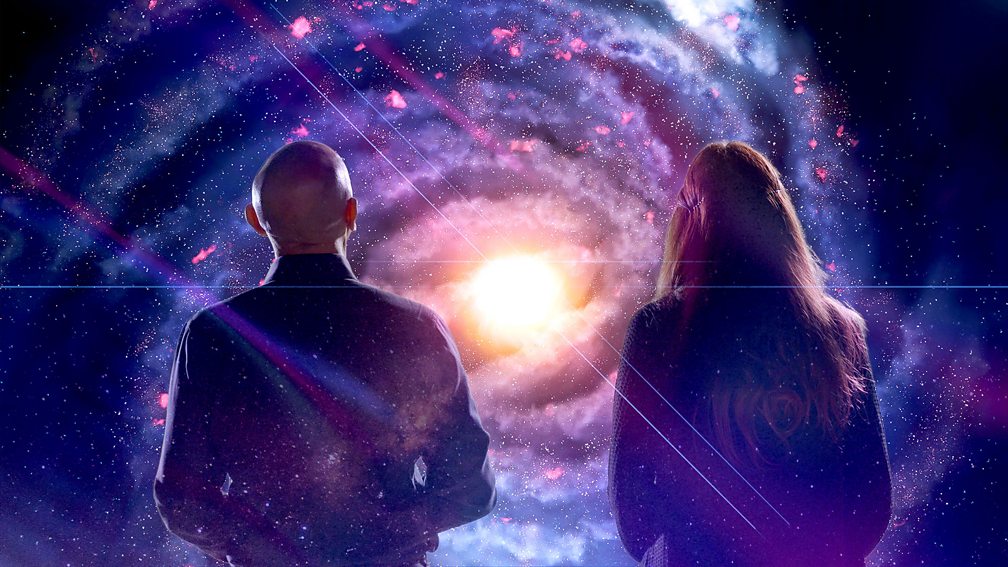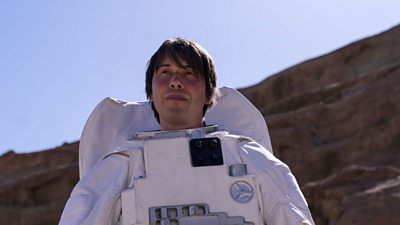
Secrets of Size: Atoms to Supergalaxies 1/4 – Going Small – BBC Science Documentary
Secrets of Size: Atoms to Supergalaxies 1/4 – Going Small – BBC Science Documentary What would the universe look like if you were a billion times smaller or a billion times bigger? In this mind-bending series, Jim Al-Khalili will look at the universe across its vast range of size, ranging from the tiniest objects measuring just a few atoms, to vast structures consisting of hundreds of thousands of interconnected galaxies. Investigating these astonishing objects will reveal fundamental truths about our universe. At the end of each film, the audience will see the largest structures ever discovered in the universe and the smallest objects whose images scientists have managed to capture to date. In the first episode, Jim will enter the Alice in Wonderland world of objects that are too tiny to glimpse with the naked eye. Starting with the smallest insects, he moves on to encounter living cells with amazing superpowers and confronts some of humanity’s deadliest enemies in the form of viruses. Going smaller still, he encounters wondrous new nanomaterials such as graphene, discovered by physicist Andre Geim. These are revolutionising engineering, medicine, computing, electronics and environmental science. Finally, Jim comes face to face with the fundamental building blocks of the world around us – atoms – and reveals why understanding the science of the ‘small’ is crucial to the future of humanity.
Secrets of Size: Atoms to Supergalaxies 2/4 – Going Big – BBC Science Documentary
Secrets of Size: Atoms to Supergalaxies 2/4 – Going Big – BBC Science Documentary In the concluding episode of the series, Jim encounters ever larger cosmic structures to reveal the latest breakthroughs in our understanding of the universe. For example, there’s the heliosphere, a vast cloud of solar plasma that surrounds and protects the solar system. Its unique physics help us understand why life is possible. Larger still, Jim comes face to face with our galactic home the Milky Way, a monstrous structure sculpted by the gravitational forces of dark matter. Jim finds out from pioneering researcher Adrian Fabian about the black hole at its centre, whose strange behaviour includes emitting the lowest note that can be heard in the cosmos. At an even greater scale, Jim encounters huge structures such as the Laniakea Supercluster, of which the Milky Way is only a tiny part. Then there’s ‘the giant arc’, a collection of galaxies that account for more than three per cent of the observable universe. Jim learns from its discoverer, British PhD student Alexia Lopez, that this gargantuan structure is forcing scientists to reassess their theory of how the universe evolves and may overturn some of the most fundamental principles in physics.
https://www.bbc.co.uk/programmes/m0017frp
BBC Factual announces three brand new science programmes
They include programmes fronted by Professor Brian Cox and Professor Jim Al-Khalili – plus a new Horizon special.

The scientists exploring space and the workings of our universe are doing some of the most awe-inspiring work on our planet today. We’re thrilled to have three new projects shining a light on these pioneers – from the Nasa teams behind the Mars rover mission and the James Webb Telescope, to the discovery of mind-boggling new horizons in Secrets of Size: Atoms to Supergalaxies. I am delighted to be showcasing these fantastic endeavours across the BBC.
Seven Days on Mars, fronted by Professor Brian Cox; Secrets of Size presented by Professor Jim Al-Khalili and a Horizon Special on the James Webb Telescope
Tom Coveney, BBC Commissioning Editor, Science, says: “The scientists exploring space and the workings of our universe are doing some of the most awe-inspiring work on our planet today. We’re thrilled to have three new projects shining a light on these pioneers – from the Nasa teams behind the Mars rover mission and the James Webb Telescope, to the discovery of mind-boggling new horizons in Secrets of Size: Atoms to Supergalaxies. I am delighted to be showcasing these fantastic endeavours across the BBC.”
Seven Days On Mars
NASA’s Perseverance rover is on the verge of changing humanity’s future. Just over a year after touching down on the red planet, Perseverance is embarking on the most demanding part of its mission to date – striking out at top speed for the sites most likely to house signs of life. To succeed, the team must overcome epic challenges and take Perseverance into uncharted territory: going further than any other rover and traversing jagged terrain – all on a hostile planet 300 million kilometres away from the Earth.
In this unique television event for BBC Two and iPlayer, Professor Brian Cox fulfils a childhood dream by going behind the scenes at Nasa’s Jet Propulsion Laboratory (JPL), mission control Mars.
Brian says: “The nature of origin of life is one of the great unanswered scientific questions. Here on Earth, life was present around 3.8 billion years ago, but the evidence for how it arose has been weathered away and erased by the geological activity of our planet. Mars, however, is a different story. It was decidedly Earth-like at the same time, with rain, rivers and lakes, but it soon entered a geological deep-freeze from which it never emerged. If there were Martians, the evidence for their emergence from the geology and chemistry of a young, active world may be far better preserved. The Perseverance Rover, and the Mars Sample Return missions to follow, may therefore answer a deeper question even than ‘Is there life on Mars?’ They may reveal how life begins across the Universe, including here on Earth, and give us unique insight into our own origins.”
In 1980 a young Brian Cox wrote to the Jet Propulsion laboratory asking for photos from Voyager and the Viking mission to Mars. These were a source of inspiration that set him on the path to becoming a physicist.
Now, over 40 years later, he has been granted privileged access to JPL – to witness the workings of the mission as it guides the Perseverance rover and the Ingenuity helicopter (the first powered aircraft we have even sent to another planet) across the surface of Mars.
Over the course of a week he joins the team as they navigate follows the rover’s every move across the floor of Jezero crater towards the remains of an ancient river delta – that may contain the evidence of ancient life on Mars.
In the process, Brian will reveal how the mission could potentially transform our understanding of life not just on Mars but Earth as well. This is the inside story of a pioneering quest into the unknown.
Seven Days on Mars, a 1×90’ for BBC Two and iPlayer, is made by Arrow Media. It was commissioned by Jack Bootle, Head of Commissioning, Science and Natural History. It is Executive Produced by Ash Potterton and Tom Brisley for Arrow Media. The director is Michael Lachmann and the Commissioning Editor is Tom Coveney. The documentary is being distributed globally by Fremantle.
James Webb Telescope: A Horizon Special (w/t)
As NASA prepares to release the first images from the James Webb Space Telescope this summer, this film tells the story of the telescope’s construction, and the extraordinary new view of our universe astronomers hope it will unveil. The successor to Hubble, and 100 times more powerful, the James Webb is the most technically advanced telescope ever built. It will look up to 300 million years further back in time than Hubble, to an era about 100 million to 250 million years after the Big Bang. Its primary mission is to see the first stars and galaxies to form in the universe, but its instruments are so sensitive it could also be the first telescope to detect signs of life on a distant planet.
However, the James Webb is a £7.6 billion gamble on the skill of its engineering team. It’s the first telescope designed to unfold in space – a complicated two-week operation in which 178 release devices must all work. If just one fails, the telescope could become a giant piece of space junk.
From its conception in the late 1980’s the construction of Webb has posed a huge technical challenge. The team must build a mirror six times larger than Hubble’s and construct a vast sunshield the size of a tennis court, fold them up so they fit into a rocket, then find a way to unfold them in space. This film tells the inside story of the James Webb Space Telescope in the words of the engineers who built it, and the astronomers who will use it.
James Webb Telescope: A Horizon Special (w/t), a 1×60’ for BBC Two and iPlayer, is made by Windfall Films. It was commissioned by Jack Bootle, Head of Commissioning, Science and Natural History. The Executive Producer is Carlo Massarella, the Producer / Director is Martin Gorst and the Commissioning Editor is Tom Coveney.
Secrets of Size: Atoms To Supergalaxies
Episode 1: Going Small, Episode 2: Going Big
What would the universe look like if you were a billion times smaller or a billion times bigger? In this mind-bending 2×60’ series for BBC Fourand iPlayer, Professor Jim Al-Khalili will see the universe at different scales, from the tiniest objects just a few atoms in size, to vast structures consisting of hundreds of thousands of interconnected galaxies. Investigating these astonishing objects will reveal fundamental truths about our universe. At the end of each film, the audience will see the largest structure ever discovered by scientists in the universe, and the smallest thing in existence which science has managed to photograph.
Jim starts off by “Going Small”. In this episode, he will enter the Alice in Wonderland world of objects that are too tiny to glimpse with the naked eye. Starting with the smallest insects, he moves on to encounter living cells with amazing super-powers and confronts some of humanities deadliest enemies in the form of viruses. Going smaller still, he encounters wondrous new nanomaterials such as graphene and its discoverer Andre Geim—these are revolutionising engineering, medicine, computing, electronics and environmental science. Ultimately, Jim comes face to face with the fundamental building blocks of the world around us—atoms. Understanding the science of the “small” is crucial to the future of humanity.
In the “Going Big” episode, Jim encounters ever larger cosmic structures to reveal the latest breakthroughs in our understanding of the universe. For example, there’s the heliosphere, a vast cloud of solar plasma which surrounds and protects the solar system. Its unique physics will help us understand how life is possible. Larger still, Jim comes face to face with our galactic home, the Milky Way, a monstrous structure sculpted by the gravitational forces of dark matter. From pioneering researcher, Andrew Fabian, Jim finds out about the black hole at its centre whose strange behaviour includes emitting the lowest note ever heard in the cosmos. At an even greater scale, Jim will encounter huge structures such as the Laniakea galactic super-cluster of which the Milky Way is a tiny part. Then there’s “the giant arc”, a collection of galaxies which spans more than three per cent of the observable universe. From its discoverer, British PhD student Alexia Lopez, Jim finds out this gargantuan structure is forcing scientists to reassess their theory of how the universe evolves and may overturn some of the most fundamental principles in physics.
Secrets of Size: Atoms to Supergalaxies, a 2×60’ for BBC Four and iPlayer, is made by Furnace TV, co-produced by The Kavli Prize. It was commissioned by Jack Bootle, Head of Commissioning, Science and Natural History. The Executive Producer is Paul Sen and the Commissioning Editor is Tom Coveney.
https://www.bbc.com/mediacentre/2022/bbc-factual-new-space-programmes
